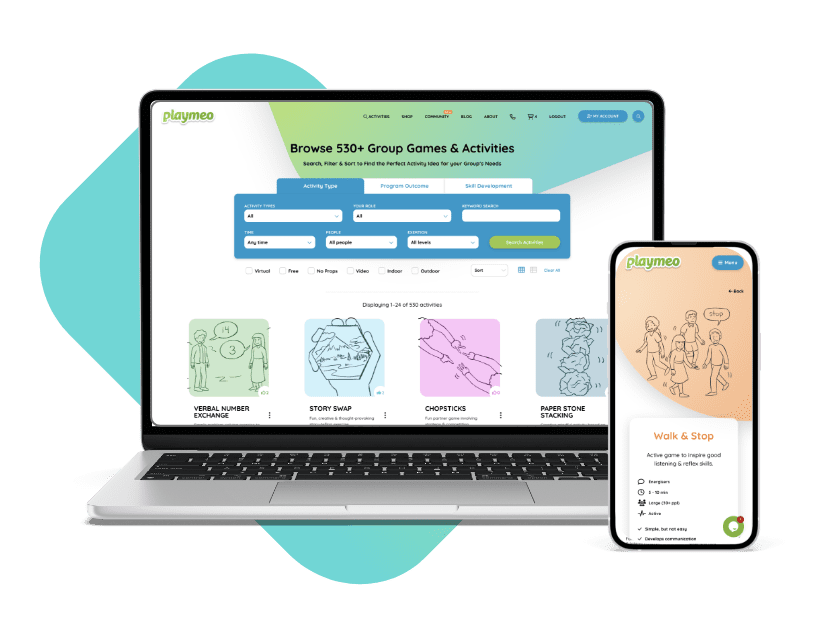Managing Large Groups with Confidence & Ease
This week’s Facilitator Tips episode shares several useful, practical strategies for how to manage large groups of people.
<< Go to Episode 41 Go to Episode 43 >>
Working with 30, 100 or many more people at the same time is very different from managing a small group of, say, 20 or fewer people. Learn how to frame this experience effectively and add a couple of new techniques to your leadership repertoire.
Click the play button above to learn how to manage large groups with confidence & ease.
Want to join the conversation?
Please leave a comment at the bottom of the page (you must be logged in.)
Don’t have a playmeo account? Join today.
Useful Links & Resources
- GRABBSS – no matter how large or small your group, the seven modalities of the GRABBSS model will help you make better programming decisions.
- Unofficial Starts – read this short article to give you a few clues to engage your group as soon as possible, with low or no supervision necessary.
- Unofficial Start Activity Ideas – as the link suggests, you’ll learn many useful, practical activity ideas to keep your group occupied as soon as they arrive.
- How to Form Random Teams – click this link to learn a bunch of fun & engaging ways to split large groups into smaller groups.
…EE
Video Transcript
Hi there and welcome to the Facilitator Tips video series, Episode 42.
My name is Mark Collard, I’m an experiential trainer and author, and today I want to focus on what to do with a large group.
Now for many people just leading any size group can be something that they’re very nervous about or very concerned about, but if you’re particularly familiar with leading groups, maybe it’s the sense of having a very large group to manage that gives you a little bit of concern. So we’re going to focus on, for me, a few tips that help working with large groups.
First of all, there’s tons of energy, and that’s one of the things I love about working with large groups is that they come with bundles of energy, and that can be fuelling you to a successful program, but take a few missteps, it could actually amplify some real negatives for you.
First of all, get started as soon as possible. There’s nothing worse than waiting around. And that is just amplified when you’ve got more people waiting for something to happen.
Pairs. It’s like your best friend when you’re working with partners. Anything that you can do that involves just partners or small groups really helps build energy as well because it’s really hard to be left out of a pair. So it’s again another really great tip.
Be heard. There are lots of different strategies that we focus on in other episodes in this series that help you as a leader be heard. But if you’re not being able to be heard, it can be very difficult to actually have your group follow you. Bring them in closer, clap your hands, project your voice, all those sorts of things can help.
Demonstrate. Perhaps you’ve got such a large group there’s no way everyone can hear you, be sure that you could be seen so that you could demonstrate what you would like your group to do. That’s really important as well. And that also serves different learning styles for people as well.
And more. When you’re working with large groups you’ve clearly got more people, well you’re going to probably need more time, more facilitators, more props, more resources, more ideas up your sleeve. Just think in terms of more. It seems obvious until of course, you realise that thing that you brought is broken and now you don’t have enough of, or more people turned up than you had anticipated.
And then random splits. This can be a really useful tip as well. Because you’ve got large groups, people tend to only keep with those people that they like or are like. That’s natural. As us, as comfort-seeking machines. But if you can use some different random splits, again in the show notes I’ll give you some examples of what I mean by that, you’ve got the opportunity to invite people to interact and build relationships.
So that’s the end of this episode, what do you do with large groups. This has been about helping you manage those groups so you can have more successful outcomes. If you’ve got some ideas, please leave a comment. I’d love to hear from you.
Indeed if you’ve got people that you work with that would value this series, please share it with them as well. Otherwise, please check the show notes for all the things that I’ve spoken of in this episode and I’ll see you next time.
Bye for now.







Hi am wondering where to find the show notes. I´m especially interested in dynamics to create sub-groups (split big groups). Thank you!
Sam, the show notes appear directly under the video. And take a look at Episode 2 How to Form Random Teams to help you develop a bunch of interesting & fun ways to split larger groups into smaller groups.